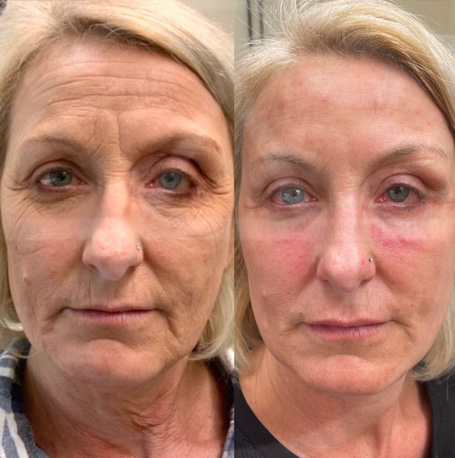
Laser Skin Resurfacing
Table of ContentsToggle Table of ContentToggle
What Is Laser Skin Resurfacing?
What Are the Types of Laser Skin Resurfacing?
There are two main types of laser skin resurfacing:
- Ablative Laser Resurfacing: Ablative lasers remove thin layers of skin, creating controlled wounds to stimulate the skin’s natural healing process. This process encourages the production of new collagen and elastin, which can lead to smoother, firmer, and more youthful-looking skin. Types of ablative lasers include carbon dioxide (CO2) lasers and erbium lasers.
- Non-Ablative Laser Resurfacing: Non-ablative lasers work beneath the skin’s surface without removing the outer layer. They target specific skin concerns and stimulate collagen production without causing visible damage to the skin’s surface. Non-ablative lasers have less downtime and may require multiple treatment sessions. Types of non-ablative lasers include fractional laser technologies.
The choice of laser resurfacing method depends on the patient’s skin type, the specific concerns being addressed, and the expected recovery time.
Laser Skin Resurfacing Procedure Overview:
Laser skin resurfacing is a cosmetic procedure that uses focused laser beams to improve the appearance and texture of the skin. The procedure typically involves the following steps:


- Consultation: The process typically begins with a consultation with Dr. Sarah Avila, a board-certified oculofacial surgeon. During this consultation, you’ll discuss your specific skin concerns, expectations, and medical history. Dr. Avila will assess your skin to determine the most appropriate laser treatment and settings for your needs.
- Preparation: Before the procedure, you will receive specific instructions on how to prepare for it. This might include avoiding sun exposure, discontinuing the use of certain skincare products like retinol, or taking prescribed medications to reduce the risk of infection. Dr. Avila may also prescribe certain medications to take prior to your procedures, such antivirals if you have a history of cold sores.
- Anesthesia: Depending on the type and depth of the laser treatment and your comfort level, you may receive one of the following forms of anesthesia:
- Local Anesthesia: Avila may apply a numbing cream or administer local anesthesia to the treatment area to minimize discomfort.
- Topical Anesthesia: For less invasive treatments, a topical numbing cream or gel may be applied to the skin.
- Sedation or General Anesthesia: Some deeper or more invasive laser resurfacing procedures may be performed with the patient under sedation or general anesthesia.
During the procedure: Dr. Avila will use the selected laser device to precisely target the skin areas of concern. The laser emits controlled beams of light that either remove the top layer of skin (ablative laser) or penetrate beneath the skin’s surface (non-ablative laser).
- Protection of Eyes and Surrounding Areas: During the procedure, protective eyewear is used to shield the patient’s eyes from the laser light. Dr. Avila may also use protective coverings to shield adjacent areas that do not require treatment.
- Laser Passes: The laser is passed over the treatment area in a controlled and systematic manner. The number of passes and the laser’s intensity are determined based on the type of laser, the depth of treatment, and the patient’s skin condition.
- Cooling and Comfort Measures: To minimize discomfort and protect the skin during the procedure, cooling devices, such as cold air or a cooling gel, may be used in conjunction with the laser treatment. Dr. Avila may also give you pro-nox, a nitrous oxide also known as laughing gas, that is inhaled for fast-acting pain relief that increases comfort and aids anxiety.
Post-Treatment Care: After the laser treatment, Dr. Avila may apply ointments or dressings to the treated areas to promote healing. You’ll receive instructions on how to care for your skin during the initial recovery period, which may include gentle cleansing, moisturizing, and sun protection.
- Recovery: Recovery time varies depending on the type and intensity of the laser treatment. Ablative laser resurfacing generally involves a more extended recovery period compared to non-ablative treatments. Patients may experience redness, swelling, and discomfort, which can be managed with prescribed medications and proper skincare.
- Follow-Up Appointments: Patients will have follow-up appointments to monitor the healing process, assess the results, and address any concerns.
It’s important to follow your healthcare provider’s post-treatment care instructions, protect your skin from sun exposure, and use recommended skincare products to maintain the results of the laser resurfacing procedure. The number of treatment sessions needed may vary based on your specific skin concerns and the type of laser used.

Sarah Avila, MD
Specialization: Eyelid Surgery & Aesthetics
Dr. Sarah Avila is an oculofacial plastic surgeon in Miami, Florida. After completing medical school, Dr. Avila completed a residency in ophthalmology at the Mount Sinai Hospital, followed by a highly competitive two-year ASOPRS-accredited fellowship in reconstructive and cosmetic oculofacial surgery at Emory University. During this fellowship, Dr. Avila focused on plastic surgery related to the eyelids, brows, lacrimal duct system, orbit, and face.



